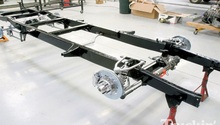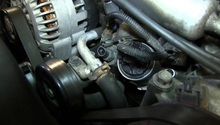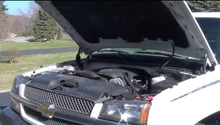Chevrolet Silverado: Suspension Diagnostic Guide
Clunk, squeak, bang, boom; fret not if your suspension is making these noises, you're not doomed.
This article applies to the Chevrolet Silverado GMT800, GMT900, and K2XX (1999-Present).
This article will help to cover some of the more common suspension related issues you may come across with your truck, whether it be new or old. Even if you don't find the answer you're looking for in here, this is a great starting place to begin an issue diagnosis.

Materials Needed
- Socket set
- Sand bags
- Tire pressure gauge
- Thermometer
Issue 1 – Rough shaking over bumps
A rough shaking while going over bumps, even small ones, can be highly annoying.
- To test, you'll first need to add some weight to the bed of the truck if it's unloaded. These trucks are made to ride the best around halfway to fully loaded in the bed. Once you've added a couple hundred pounds or more to the bed, go for a test drive again. If the shaking is less noticeable, it's most likely just the normal way the truck will ride unloaded. This is especially true for the trucks with longer frames. If you drive a regular cab, short bed this won't be as noticeable of an issue.
- If adding weight didn't improve anything, you'll need to inspect the steering linkage. Any play can cause vibrations or shaking, and the steering linkage will most likely need to be replaced.
- If the steering linkage is tight, next on the list are the shocks. If you have 60k+ miles or do a lot of off-road, these can be due for a replacement.
- Last on the list is to get a fresh alignment and to get the tires road forced balanced. Road force balancing can help find any issues that a normal tire balance would miss; however, it is also more expensive to have performed.

Issue 2 – Squeaking or grinding sounds over bumps
There are multiple causes for a squeaking or grinding sound while going over bumps, but first you'll need to figure out what type of sound it is.
- Squeaking sounds are generally caused by rubber rubbing against rubber or metal, and normally means you should inspect all bushings around the truck for them to be cracking. To diagnose which bushing it is, you can grease them one by one and test in between until the sound goes away.
- Grinding sounds are generally caused by metal rubbing against metal. You'll need to inspect for any loose components or wear marks and tighten/replace as necessary.

Issue 3 – Grinding sounds from the rear end
Unfortunately, a grinding sound coming from the rear end is a sign that something is going to go severely wrong, and could get very expensive soon if not corrected immediately.
- First, you'll want to check the brakes as one could be locked up. The easiest way to check is to go for a drive where you brake hard a lot. Then you'll need to get out quickly and using a laser thermometer, take the temperature of both brake housings. They should be pretty similar in temperature; any variances of 50 to 75 degrees is a sign there's an issue with the brakes on that side since it's much hotter than the other.
- If the brakes are okay, you'll need to drain the rear differential housing. Inspect the old fluid coming out for any metal shavings the size of a fingernail clipping or larger. If no shavings are found in the drained fluid, you'll need to pull the differential cover off and check for shavings on the inside. If any are found, you'll need to have rear differential rebuilt or replaced.

Issue 4 – Rattling from the front end
The two most common causes of rattling from the front end are loose skid plates or loose sway bar end links. Pretty much anything else is going to give you more severe problems than just a rattling sound. However, you'll still want to go through and tighten anything that has loosened up.

Issue 5 – Excessive body roll
There are a couple different things that can lead to body roll, so you'll need to check them all:
- A tire with too little pressure can lead to body roll due to the sidewall flex of the tire. Likewise, a tire with too much pressure can cause body roll due to the smaller contact patch with the ground. It's important to always keep your tire pressure in check to maximize both safety and tire lifespan.
- Worn out shocks can cause body roll due to them not dampening properly when cornering and having too slow of a return. As a general rule of thumb, shocks last for about 60 to 80k miles of street driving and about half that for off-road driving.
- Worn out body mounts and bushings can also cause body roll issues. The bushings are what cushion the body on top of the frame; if they begin to dry and crack, they won't give the same support that is needed when taking sharp corners.

Issue 6 – Vibration on lifted trucks
The most common cause of a vibration while driving on a lifted truck is a bad pinion angle on the drive shaft. By lifting the truck, the pinion angle is changed and angles that are too severe can cause drive shaft vibrations. While they do sell pinion shim kits, the best idea is to go to a drive shaft shop to either have a new drive shaft made, or the factory one lengthened and re-balanced.

Related Discussion
- Silverado Suspension Problem - ChevroletForum.com
- Front Suspension Rattle - ChevroletForum.com
- Rear End Problems - ChevroletForum.com
- Silverado Problems - ChevroletForum.com
- 6-Inch Lift Vibration - ChevroletForum.com






